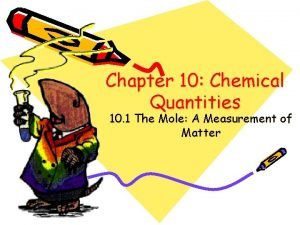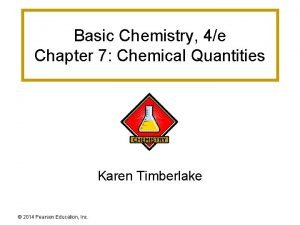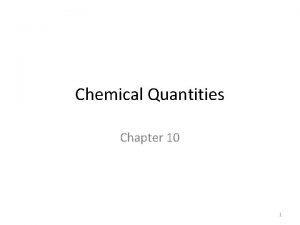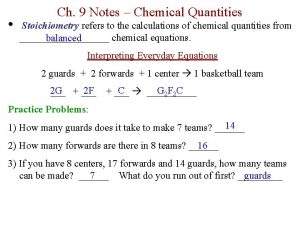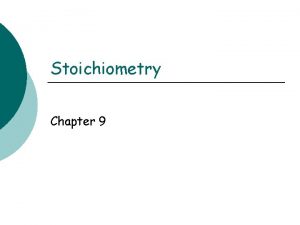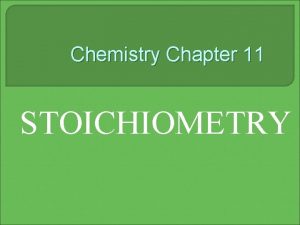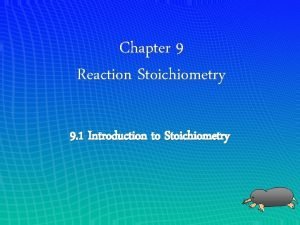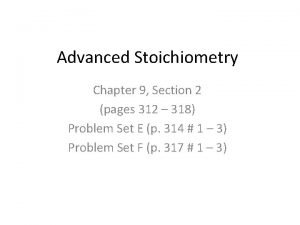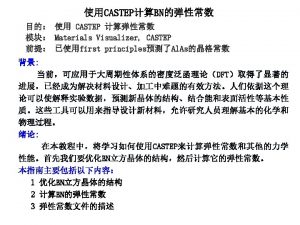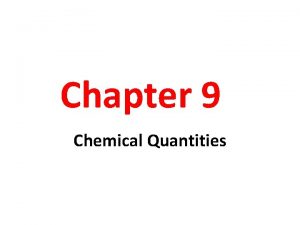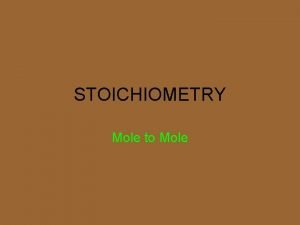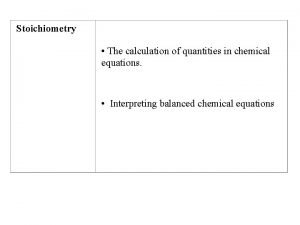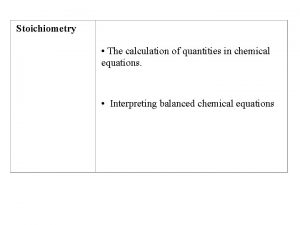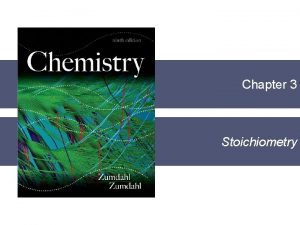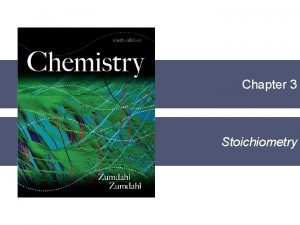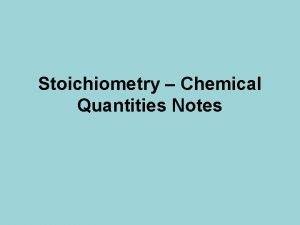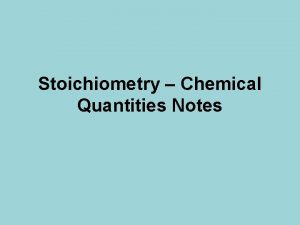Chapter 12 Stoichiometry 1 Stoichiometry Calculation of quantities

















- Slides: 17

Chapter 12 Stoichiometry 1

Stoichiometry • Calculation of quantities in chem rxns. 2

Mole Ratio --- particles N 2 (g) + 3 H 2 (g) → 2 NH 3 (g) 1 molecule of N 2 reacts with 3 molecules H 2 to yield 2 molecules of ammonia (NH 3). Ratio is 1: 3: 2 1 mole of nitrogen reacts with 3 moles of hydrogen to yield 2 moles of ammonia. 3

Mole Ratio N 2 (g) + 3 H 2 (g) → 2 NH 3 (g) mol N 2 : mol H 2 = mol N 2 : mol NH 3 = mol H 2 : mol NH 3 = 1: 3 1: 2 4

Volume & Mole N 2 (g) + 3 H 2 (g) → 2 NH 3 (g) At STP, 22. 4 L N 2 react with 3 x 22. 4 L H 2 to form 2 x 22. 4 L NH 3 • volume applies only for gases Avogadro Principle Ø 1 mole of any gas occupies 22. 4 L at STP. 5

Mole to Mole 1. How many moles ammonia are produced when 0. 60 mol nitrogen reacts with hydrogen? N 2(g) + 3 H 2(g) → 2 NH 3(g) 6

Mass to Mass 2. Calculate the # g ammonia produced by the rxn of 5. 4 g hydrogen with an excess of nitrogen. N 2 (g) + 3 H 2 (g) → 2 NH 3 (g) 7

Mass to Mass 3. Acetylene gas (C 2 H 2) is produced by adding water to calcium dicarbide (Ca. C 2). Ca. C 2 (s) +2 H 2 O(l) → C 2 H 2 (g) + Ca(OH)2 (aq) How many g of acetylene are produced by adding water to 5. 00 g Ca. C 2? 8

Mass to # of Particles 4. How many molecules of oxygen are produced when a sample of 29. 2 g of water is decomposed by electrolysis? 2 H 2 O (l) electricity 2 H 2 (g) + O 2 (g) 9

Volume to Mole 5. Assuming STP, how many L of oxygen are needed to produce 19. 8 L SO 3? 2 SO 2 (g) + O 2 (g) → 2 SO 3 (g) 10

Mole & Volume 6. The eqn for the combustion of carbon monoxide is 2 CO (g) + O 2 (g) → 2 CO 2 (g) How many L of oxygen are required to burn 3. 86 L of carbon monoxide at STP? 11

CST example 1 Mg 3 N 2(s) + 6 H 2 O (l) → 2 NH 3(aq) + 3 Mg(OH)2(s) If 54. 0 g of water are mixed with excess magnesium nitride, then how many g of ammonia are produced? A 1. 00 B 17. 0 C 51. 0 D 153 12

CST problem 2 Fe 2 O 3 + 3 CO → 2 Fe + 3 CO 2 In this rxn, how many g of Fe 2 O 3 are required to completely react with 84 g of CO? A 64 g B 80 g C 160 g D 1400 g 13

CST problem 3 A mass of 5. 4 g of aluminum (Al) reacts with an excess of copper (II) chloride (Cu. Cl 2) in soln, as shown below. 3 Cu. Cl 2 + 2 Al → 2 Al. Cl 3 + 3 Cu What mass of solid copper (Cu) is produced? A 0. 65 g B 8. 5 g C 13 g D 19 g 14

The End 15

2. How many g of H 2 O can be formed from 24. 0 g O 2 and 6. 00 g H 2? • 30. 0 g • 27. 0 g • 54. 0 g • 13. 5 g

3. Octane burns according to the following eqn. 2 C 8 H 18 + 25 O 2 16 CO 2 + 18 H 2 O What is the % yield if 14. 6 g of CO 2 are produced when 5. 00 g of C 8 H 18 are burned? • 106% • 94. 8% • 34. 2% • 62. 5%
 Linear to angular velocity
Linear to angular velocity The calculation of quantities in chemical equations
The calculation of quantities in chemical equations The calculation of quantities in chemical equations
The calculation of quantities in chemical equations Stoichiometry chapter 11 study guide
Stoichiometry chapter 11 study guide Chapter 7 chemical quantities answer key
Chapter 7 chemical quantities answer key Chemistry chapter 10 chemical quantities
Chemistry chapter 10 chemical quantities Chapter 7 chemical quantities answer key
Chapter 7 chemical quantities answer key Molar mass map
Molar mass map Chapter 10 chemical quantities practice problems answer key
Chapter 10 chemical quantities practice problems answer key Slidetodoc.com
Slidetodoc.com Chapter 9 chemical quantities
Chapter 9 chemical quantities Chemistry chapter 9 stoichiometry
Chemistry chapter 9 stoichiometry Chapter 9 review stoichiometry section 3
Chapter 9 review stoichiometry section 3 Chemical equation defintion
Chemical equation defintion Stoichiometry chapter 9 test
Stoichiometry chapter 9 test Stoichiometry introduction
Stoichiometry introduction The first step in most stoichiometry problems is to
The first step in most stoichiometry problems is to Percentage yield
Percentage yield





